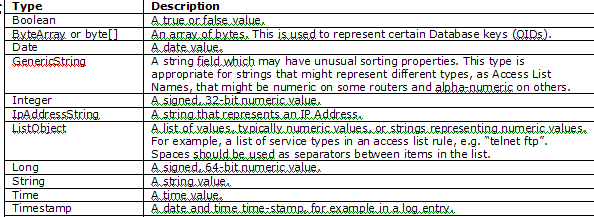Understanding the Data Model
The Data Model is comprised of Objects that are represented in Database tables. This allows the contents of the Objects to easily be searched, displayed by the User Interface, formatted into Reports, and subject to Compliance Tests.
Each of these Objects has a set of Attributes that may be present. Some Attributes are required to be present, whereas others are optional.
While most of the Attributes in an Object typically represent information collected about the Device's configuration or operational state, all Objects in the Database have some additional Attributes that are used to facilitate their storage in the database, such as database keys.
The Attributes may be of various types. Here are the currently supported primitive types.

The external representation of the Data Model is defined by an XML schema known as the DeviceConfigurationState.xsd, and other associated Metadata maintained in Network Configuration Manager's Database, and in the Device Packages.
The schema is subdivided into Configuration Units, which represent a unit of information that Device drivers know how to pull or push .
Each Device Package may have its own unique set of supported Configuration Units, however a Configuration Unit must be configured in the Metadata to be accessible by Network Configuration Manager.
The Metadata used by the application is visible within the application, by selecting Tools then Metadata.
See: Object Types